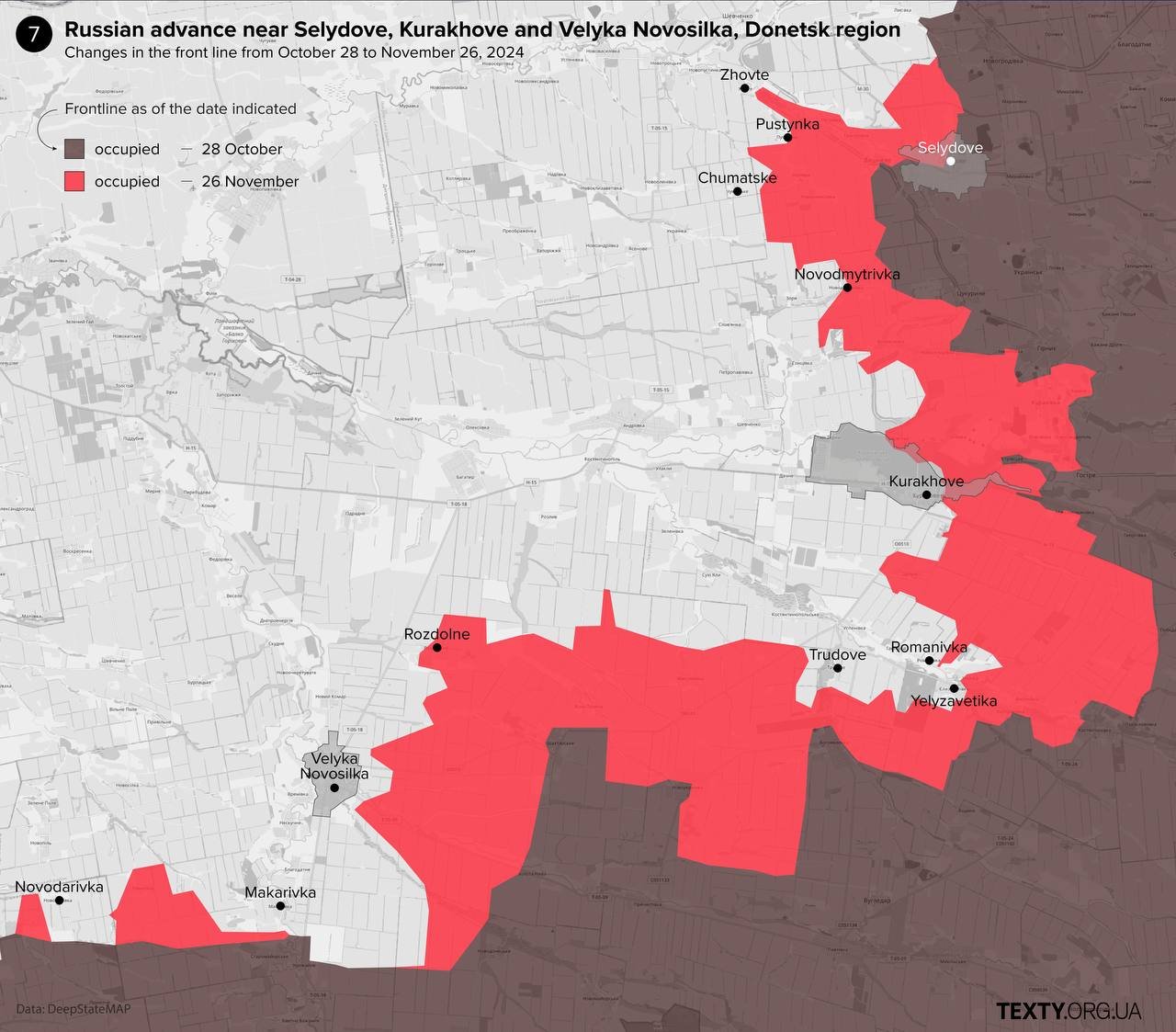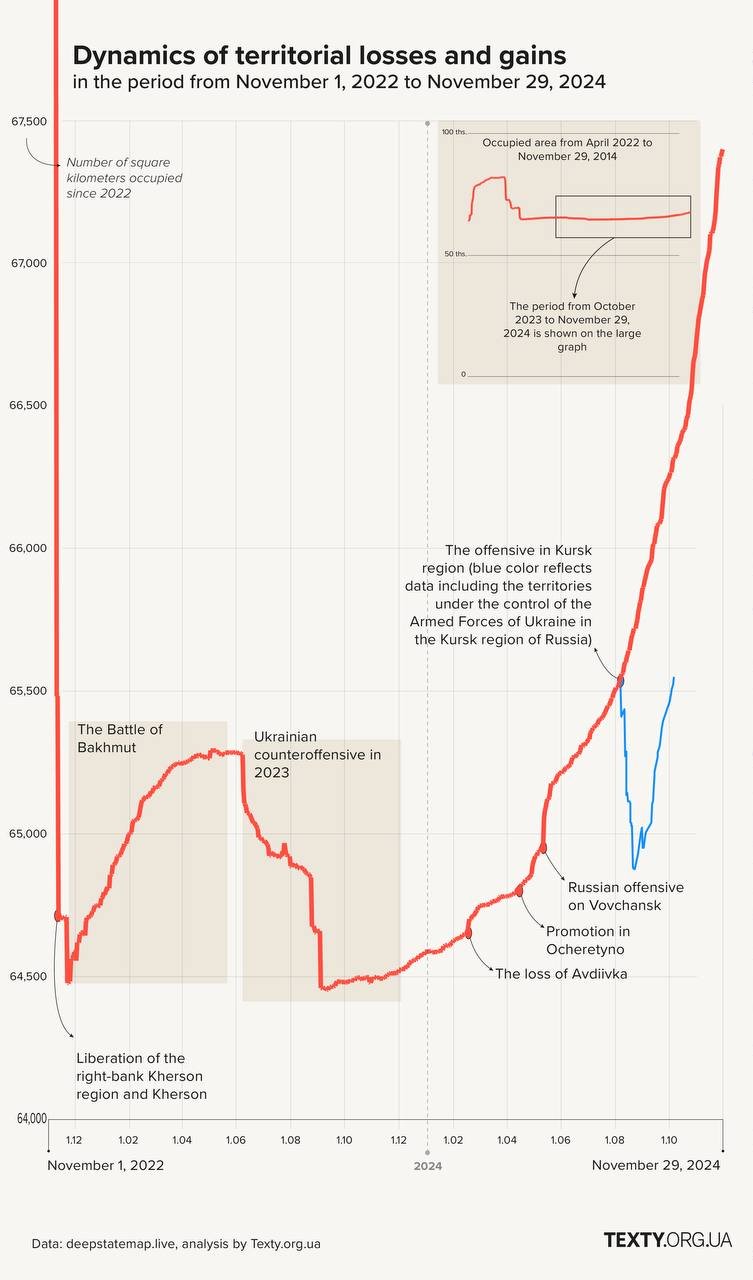How Russia advanced in November and how its losses increased: Battle map
Throughout November, the hotspots along the frontlines remained unchanged, as did the tactics of the Russian forces. Their advance showed a slightly higher pace compared to October, while the number of their casualties increased. However, it is still not enough to significantly slow down their offensive.
The Pokrovsk and South Donetsk directions have become the traditional areas of the most intense Russian advances over the past four weeks, as shown on the map. These are the regions where the occupiers have achieved their largest territorial gains. Below, we will describe only the areas where the heaviest fighting is taking place.

Pokrovsk and Kurakhove
Currently, the enemy is approximately 5 kilometers from Pokrovsk and about 15 kilometers from the border of the Dnipropetrovsk region.

Russian forces have attempted to flank Kurakhove, and fighting has already begun within the city. They are also gradually pushing Ukrainian forces south of the city, near the settlements of Romanivka and Yelyzavetivka.
What is even more concerning for Ukrainian troops is the enemy's strikes toward the Vremivka ledge, aiming to cut off communications with Velyka Novosilka. If successful, it would put southern Donetsk in a critical situation.
The Russians continue to employ the same tactics, showing little innovation: flanking settlements, cutting off supply routes, and slowly forcing Ukrainian units out of another "quasi-pocket."
Their forces advance in small groups, often taken out by drones, artillery, or mortars. Yet they keep coming. Eventually, after numerous failed attempts, someone manages to cross the contested zone and find cover. Alternatively, taking advantage of the Defense Forces' lack of manpower, they find paths with minimal resistance.
Once entrenched in a basement, trench, or dugout, they accumulate forces, bring in ammunition, and then proceed further. This approach is slow and requires high casualties, but as we see, the Kremlin deems it acceptable.
Despite all this, the Russians have failed to achieve their dream scenario of fully encircling and trapping Ukrainian forces in a complete pocket.
However, the Russian tactics, while slow, are yielding results. Real-time developments show the occupiers trying to push Ukrainian troops out of the semi-surrounded Kurakhove, capturing several settlements north of the city and the reservoir while simultaneously advancing south of it.
A similar strategy is being employed near Pokrovsk, where they avoid a direct assault on the city and instead focus on capturing villages to its south, such as Pustynka and Zhovte. The next target could be Shevchenko.
Oskil River
Another area of active Russian advance, albeit receiving less media attention, is the territory beyond the Oskil River.

Earlier, Russian forces managed to split the Ukrainian grouping in this area, reaching the banks of the Oskil River and cutting off one of the supply routes to the right bank. Now, the occupiers are "converting" these gains into further territorial advances on the left bank, while periodically attempting to establish positions on the right bank—efforts that have so far failed.
Kupiansk
The occupiers’ “march” toward Kupiansk, however, ended with a resounding failure.

A column of enemy equipment, which somehow managed to break through nearly to the city on November 13, was destroyed by Ukrainian forces. Subsequently, the infantry that managed to disembark was either eliminated or captured.
Toretsk and Chasiv Yar

The enemy also made minor advances in the urban areas of Toretsk and Chasiv Yar.
Support TEXTY.org.ua
TEXTY.ORG.UA is an independent media without intrusive ads and puff pieces. We need your support to continue our work.
Despite the optimistic claims by Russian war correspondents months ago that Putin had ordered the complete takeover of Ukrainian-controlled territories in the Kursk region by October 1, as of late November, most of these territories remain under the control of the Ukrainian Armed Forces.
Kursk Region

No new deadlines for "liberation" have been announced by Russian war correspondents so far.
Rate of Advance
To clarify whether the pace of the enemy’s advance has increased or decreased, we’ve updated our graphs to illustrate this. The higher the curve rises, the faster the Russians are advancing. As shown in the graph below, in November, compared to October, the Russians slightly increased their pace, with the curve climbing even more steeply.


An important factor shaping the course of the war is the number of killed and wounded Russian soldiers. As seen in the graph below, these numbers are rising, which is good news. However, the increase is not happening quickly enough to significantly slow their advance.



